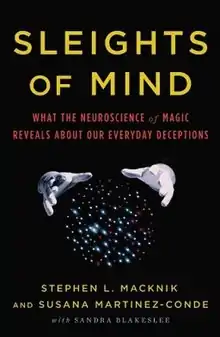Sleights of Mind
Sleights of Mind: What the Neuroscience of Magic Reveals about Our Everyday Deceptions is a 2010 popular science book, written by neuroscientists Stephen Macknik and Susana Martinez-Conde, with science writer Sandra Blakeslee.[1] Working alongside some of the world’s greatest magicians, Macknik and Martinez-Conde studied how conjuring techniques trick the brain. Sleights of Mind considers the greater implications of magic and misdirection for clinical conditions such as autism, and for everyday life situations, including choice and trust in personal and business relationships.
 First edition | |
| Author | Stephen Macknik, Susana Martinez-Conde and Sandra Blakeslee |
|---|---|
| Subject | Neuroscience, Magic, Neuromagic |
| Genre | Non-fiction |
| Publisher | Henry Holt and Co. |
Publication date | November 9, 2010 |
| Pages | 291 pp. |
| ISBN | 978-0312611675 |
Sleights of Mind is the result of Macknik and Martinez-Conde’s yearlong, world-wide exploration of magic and how its principles apply to human behavior. Sleights of Mind introduces Neuromagic as a new area of scientific endeavor, a discipline aimed to uncover the interaction between brain science and the art of magic. Macknik and Martinez-Conde propose that understanding how the mind perceives magic and illusion will provide a greater understanding of perception and cognition at large.
Synopsis
Macknik and Martinez-Conde say that magic tricks fool us because humans have hardwired processes of attention and awareness that are hackable. Good magicians use our inherent mental and neural limitations against us by leading us to perceive and feel what we are neurologically inclined to. Working with renowned magicians like Apollo Robbins, Teller, Mac King, and James Randi, Macknik and Martinez-Conde research the ways in which the perceptual and cognitive elements of magic relate to more than simple deceits.[2] The authors reveal the neural underpinnings of the magical methods that explain how our brains perceive magic.
Through their exploration, Macknik and Martinez-Conde uncover how our brains work in everyday situations. They describe how if you have ever bought an expensive item you had sworn you would never buy, the salesperson was creating the “illusion of choice,” a core technique of magic. They also relate the use of magic to Bernie Madoff’s “illusion of trust”. Through these examples, Macknik’s and Martinez-Conde’s Sleights of Mind illuminates the reasons for studying magic, and its implications for research on, and renewed understanding of, perceptual and cognitive processes.
Critical reception
The book has been reviewed by authors of other science-related books, including Neil deGrasse Tyson, Dan Ariely and JJ Abrams. It has also been reviewed in the New York Times[2][5] and The Wall Street Journal.[6]
The book has a 4.3 out of 5 star rating on both Amazon[7] and Barnes & Nobles,[8] and a 3.9 star rating on Goodreads.[9]
References
- World Archipelago. "Sleights of Mind". Macmillan.
- "About the Book, Sleights of Mind by Stephen Macknik & Susana Martinez-Conde with Sandra Blakeslee". sleightsofmind.com.
- "The best books of the year". standard.co.uk. November 17, 2011. Retrieved June 30, 2015.
- "Memoria de Actividades FEYCT 2013" (PDF). Fundación Española para la Ciencia y la Tecnología.
- "JJ Abrams: By the book". nytimes.com. October 10, 2013. Retrieved June 30, 2015.
- "How Visual Illusions Work". www.wsj.com. November 20, 2010. Retrieved August 9, 2019.
- https://www.amazon.com/Sleights-Mind-Neuroscience-Everyday-Deceptions/product-reviews/0312611676/ref=cm_cr_dp_d_show_all_top?ie=UTF8&reviewerType=all_reviews
- Noble, Barnes &. "BN No Results Page". Barnes & Noble.
- "Sleights of Mind". www.goodreads.com.
External links
- "How Visual Illusions Work". The Wall Street Journal. November 20, 2010. Retrieved August 12, 2019.
- "It's a Kind of Magic!". Birmingham Skeptics. June 25, 2011. Retrieved August 12, 2019.
- "Sleights Of Mind In Healthcare: Do You Believe In Magic". Women 2.0. December 7, 2011. Retrieved August 12, 2019.
- "Sleights of mind". Curious Book Fans. February 6, 2011. Retrieved August 12, 2019.
- "Review: Sleights of Mind: What the Neuroscience of Magic Reveals About Our Everyday Deceptions". Dana Foundation. January 31, 2011. Retrieved August 12, 2019.